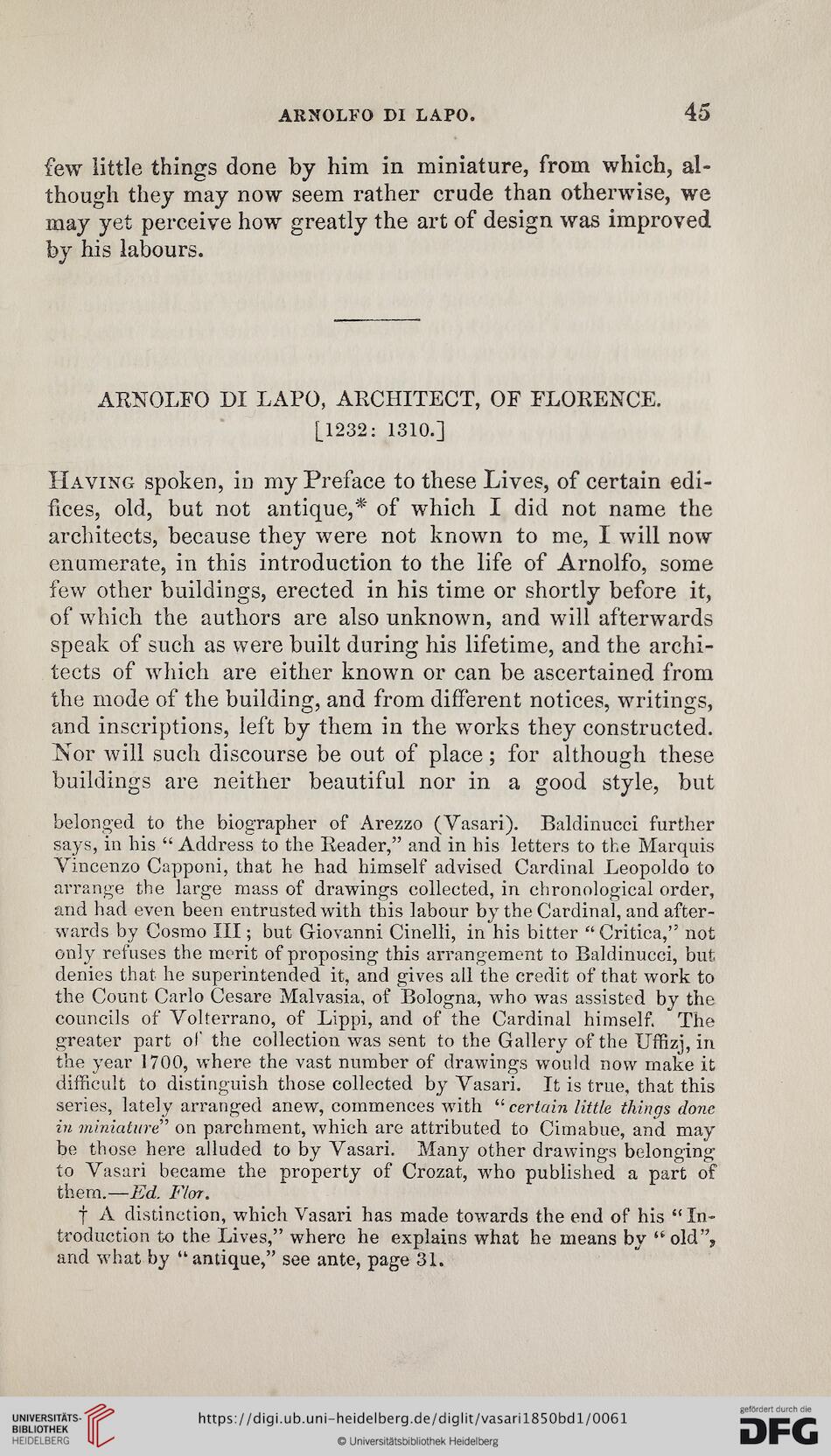ARNOLFO DI LAPO.
45
few little things done by him in miniature, from which, al-
though they may now seem rather crude than otherwise, we
may yet perceive how greatly the art of design was improved
by his labours.
ARNOLFO DI LAPO, ARCHITECT, OF FLORENCE.
[1232: 1310.]
Having spoken, in my Preface to these Lives, of certain edi-
fices, old, but not antique,* of which I did not name the
architects, because they were not known to me, I will now
enumerate, in this introduction to the life of Arnolfo, some
few other buildings, erected in his time or shortly before it,
of which the authors are also unknown, and will afterwards
speak of such as were built during his lifetime, and the archi-
tects of which are either known or can be ascertained from
the mode of the building, and from different notices, writings,
and inscriptions, left by them in the works they constructed.
Nor will such discourse be out of place; for although these
buildings are neither beautiful nor in a good style, but
belonged to the biographer of Arezzo (Vasari). Baldinucci further
says, in his “ Address to the Reader,” and in his letters to the Marquis
Vincenzo Capponi, that he had himself advised Cardinal Leopoldo to
arrange the large mass of drawings collected, in chronological order,
and had even been entrusted with this labour by the Cardinal, and after-
wards by Cosmo III; but Giovanni Cinelli, in his bitter “ Critica,” not
only refuses the merit of proposing this arrangement to Baldinucci, but
denies that he superintended it, and gives all the credit of that work to
the Count Carlo Cesare Malvasia, of Bologna, who was assisted by the
councils of Volterrano, of Lippi, and of the Cardinal himself. The
greater part of the collection was sent to the Gallery of the Uffizj, in
the year 1700, where the vast number of drawings would now make it
difficult to distinguish those collected by Vasari. It is true, that this
series, lately arranged anew, commences with “ certain little things done
in miniature” on parchment, which are attributed to Cimabue, and may
be those here alluded to by Vasari. Many other drawings belonging
to Vasari became the property of Crozat, who published a part of
them.—Ed. Flor.
f A distinction, which Vasari has made towards the end of his “ In-
troduction to the Lives,” where he explains what he means by “ old”,
and what by “ antique,” see ante, page 31.
45
few little things done by him in miniature, from which, al-
though they may now seem rather crude than otherwise, we
may yet perceive how greatly the art of design was improved
by his labours.
ARNOLFO DI LAPO, ARCHITECT, OF FLORENCE.
[1232: 1310.]
Having spoken, in my Preface to these Lives, of certain edi-
fices, old, but not antique,* of which I did not name the
architects, because they were not known to me, I will now
enumerate, in this introduction to the life of Arnolfo, some
few other buildings, erected in his time or shortly before it,
of which the authors are also unknown, and will afterwards
speak of such as were built during his lifetime, and the archi-
tects of which are either known or can be ascertained from
the mode of the building, and from different notices, writings,
and inscriptions, left by them in the works they constructed.
Nor will such discourse be out of place; for although these
buildings are neither beautiful nor in a good style, but
belonged to the biographer of Arezzo (Vasari). Baldinucci further
says, in his “ Address to the Reader,” and in his letters to the Marquis
Vincenzo Capponi, that he had himself advised Cardinal Leopoldo to
arrange the large mass of drawings collected, in chronological order,
and had even been entrusted with this labour by the Cardinal, and after-
wards by Cosmo III; but Giovanni Cinelli, in his bitter “ Critica,” not
only refuses the merit of proposing this arrangement to Baldinucci, but
denies that he superintended it, and gives all the credit of that work to
the Count Carlo Cesare Malvasia, of Bologna, who was assisted by the
councils of Volterrano, of Lippi, and of the Cardinal himself. The
greater part of the collection was sent to the Gallery of the Uffizj, in
the year 1700, where the vast number of drawings would now make it
difficult to distinguish those collected by Vasari. It is true, that this
series, lately arranged anew, commences with “ certain little things done
in miniature” on parchment, which are attributed to Cimabue, and may
be those here alluded to by Vasari. Many other drawings belonging
to Vasari became the property of Crozat, who published a part of
them.—Ed. Flor.
f A distinction, which Vasari has made towards the end of his “ In-
troduction to the Lives,” where he explains what he means by “ old”,
and what by “ antique,” see ante, page 31.




